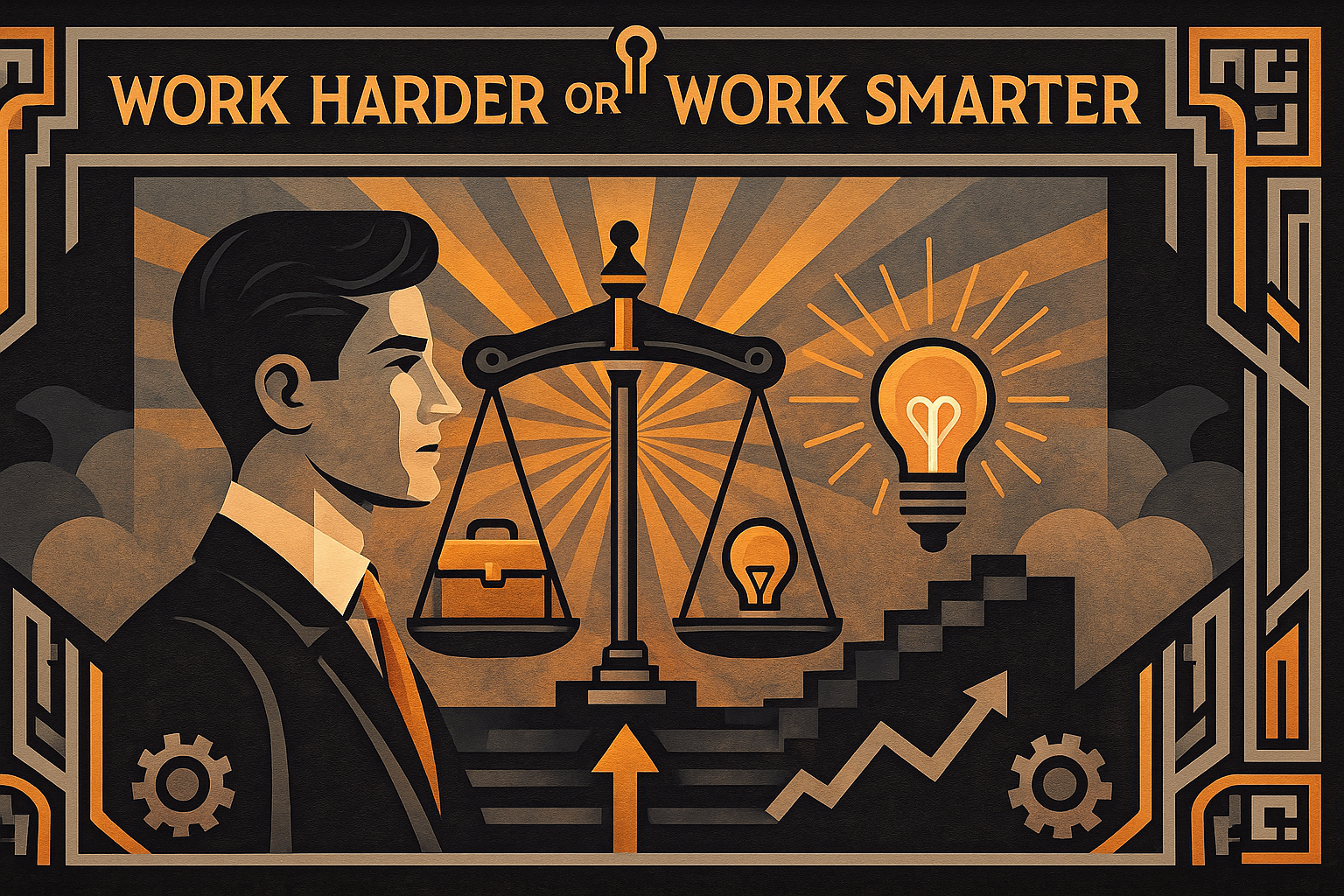Skill Stacking: The Smartest Way to Boost Your Income Early in Your Career

Skill Stacking: The Ultimate Cheat Code for Career Growth
If you’re an early-career professional, you’ve probably asked yourself:
• “How do I grow my income without waiting years for promotions?”
• “How can I stand out in a competitive job market?”
The answer isn’t just working harder—it’s working smarter. And that’s where skill stacking comes in.
TL/DR
Skill stacking is the strategic process of combining multiple skills to amplify your career value. Instead of being just a graphic designer, you become a designer who knows motion graphics and UX/UI design. Instead of just a writer, you become a content strategist with SEO expertise. This career skills combination not only increases your job security but also opens doors to high-income skills that can accelerate your professional growth. In some cases, an additional skill set can lead you down an entirely new career path! For an aspiring leaders, skill stacking also plays a strategic role, in helping you to build expertise in different departments, it prepares you for leading an entire organization later. Do you work in Sales? Great! Can you learn Sales Analytics? Perfect. Not only will you increase your income short term, but you are better positioning for that VP of Sales role later.
In this guide, we’ll break down:
✅ What skill stacking is and why it’s a game-changer
✅ How to choose the right skills to stack for maximum career impact
✅ Ways to monetize your skill stack and boost your income
What is Skill Stacking?
Skill stacking is the process of acquiring multiple complementary skills that, when combined, make you significantly more valuable and versatile in your field. Instead of trying to become the absolute best in the world at a single skill—an approach that can take years—you can accelerate your career growth by strategically building a high-demand skill set that makes you stand out.
By layering new skills on top of your existing knowledge, competencies, and experience, you shorten the learning curve and can quickly apply new techniques to deliver results. This is because many skills share transferable principles that allow for faster mastery of related disciplines.
For example, consider design skills—whether you’re creating a website, a mobile app, or a 3D-rendered environment, the core principles of design remain the same:
• Understanding color theory, composition, and typography
• Prioritizing user experience and intuitive layouts
• Developing a strong design aesthetic and taste
While the tools and platforms may differ—a web designer might use Figma, whereas a 3D artist relies on Blender or Unreal Engine—the ability to create visually compelling and functional designs applies across disciplines. By stacking skills, a designer who learns motion graphics or UX/UI principles increases their career opportunities and can command higher salaries or freelancing rates.
This principle applies to virtually any field:
• A writer who learns SEO and digital marketing becomes a content strategist who can drive traffic and revenue.
• A software developer who learns AI/ML moves into high-demand AI-powered applications and machine learning engineering.
• A sales professional who understands data analytics can use insights to optimize strategies and increase revenue generation.
By focusing on complementary and strategic skill stacking, you create a unique combination of abilities that maximizes your value, adaptability, and income potential in today’s fast-changing job market.
This version adds clarity, real-world applications, and a more compelling case for why skill stacking accelerates professional success. Let me know if you’d like further refinements! 🚀
Why Skill Stacking Works (and Why Your Boss will Love It too)
Today’s job market is evolving at an unprecedented pace. Industries are being reshaped by technology, automation, and shifting business needs, which means that employers aren’t just looking for specialists who excel in one area—they want versatile professionals who can adapt, solve problems across multiple domains, and drive results.
By leveraging skill stacking, you position yourself as a well-rounded, high-value professional who stands out from the competition. Here’s how skill stacking gives you a competitive edge:
🔹 More Hireable – Stand Out in a Crowded Job Market
Gone are the days when a single degree or one specialized skill was enough to secure long-term job security. Employers now prioritize candidates who bring multiple in-demand skills to the table.
• A marketing professional who understands SEO, copywriting, and social media advertising becomes far more attractive than someone with only one of those skills.
• A project manager who knows data analytics, automation tools, and stakeholder management is more likely to land leadership roles.
• A software developer who also understands UX design and business strategy becomes a key asset for tech-driven companies.
Having a broader skill set increases the number of job opportunities available to you, allowing you to apply for a wider range of positions and pivot into new industries more easily.
🔹 More Valuable – Employers Love Versatile Professionals
Hiring multiple specialists for different tasks can be costly for businesses. That’s why companies love professionals who can wear multiple hats and contribute in different ways. Skill stacking makes you a high-value asset because you bring a unique blend of expertise that companies would otherwise need to hire multiple people to cover.
• A graphic designer with motion graphics and UX/UI skills can take on branding, app design, and video content creation—reducing the need for multiple hires.
• A content writer who also knows SEO, analytics, and digital marketing can write, optimize, and measure content performance—saving the company time and money.
• A sales professional with data analytics expertise can forecast trends, analyze customer behavior, and refine sales strategies—driving higher revenue for the business.
By developing a combination of skills that complement each other, you make yourself indispensable to your employer or clients.
🔹 More Adaptable – Future-Proof Your Career
Industries change rapidly, and job roles that exist today might not exist in five years. The ability to adapt and learn new skills quickly is becoming one of the most valuable traits for professionals. Skill stacking ensures that you stay ahead of the curve rather than being left behind.
Consider how the job market has changed in recent years:
• AI and automation have replaced repetitive tasks, forcing employees to expand into strategy, creativity, and problem-solving roles.
• Remote work and digital transformation have increased demand for digital collaboration, virtual communication, and tech-savviness.
• The rise of no-code tools has allowed non-developers to build websites, automate tasks, and launch online businesses.
Professionals who continuously learn and adapt remain in high demand, even when industries shift. A data analyst who learns machine learning, for example, can transition into AI-driven analytics roles. A journalist who learns video editing and podcasting can evolve into multimedia content production.
Skill stacking future-proofs your career by giving you the flexibility to navigate change and stay relevant in an evolving job market.
🔹 Better Paid – More Skills, More Negotiating Power
At the end of the day, the more value you bring, the more you can charge—whether you’re negotiating a salary increase, switching to a higher-paying role, or offering freelance services.
• Employees: When you bring multiple valuable skills to your company, you become an asset they can’t afford to lose. This gives you leverage to negotiate higher salaries, promotions, or expanded responsibilities.
• Freelancers & Entrepreneurs: If you can offer a combination of services, you can command premium rates. For example, a web designer who also writes conversion-optimized copy can charge double the price compared to a designer who only focuses on visuals.
• Side Hustlers & Business Owners: Skill stacking enables you to diversify your income streams. A career coach who learns digital marketing can sell online courses, write eBooks, or offer group coaching sessions, rather than relying solely on one-on-one consultations.
The more skills you combine strategically, the higher your earning potential becomes.
Skill Stacking in Action: High-Impact Career Pathways
Skill stacking works across all industries—it’s about strategically combining complementary skills to maximize your career growth, income, and opportunities. Below are expanded career paths demonstrating how stacking skills can elevate your professional trajectory:
🚀 Tech & Engineering
📌 Software Engineer → AI/ML Specialist → Technical Product Manager → CTO
🔹 Why it works: AI and machine learning are shaping the future of technology. Adding ML and business strategy to development skills prepares engineers for leadership roles.
📌 Data Analyst → SQL & Python → Machine Learning → Data Scientist
🔹 Why it works: Companies are investing in big data and AI, making advanced data skills a key differentiator.
📌 UX Designer → Front-End Development → Product Designer → Design Lead
🔹 Why it works: Knowing both UX/UI design and coding allows designers to work more closely with developers and take on higher-level product roles.
📈 Business & Marketing
📌 Content Writer → SEO Expert → Video Content Creator → Brand Strategist
🔹 Why it works: Companies prioritize content marketing, and professionals who understand SEO, multimedia, and brand positioning have an edge over standard writers.
📌 Social Media Manager → Digital Advertising → Email Marketing → Growth Marketer
🔹 Why it works: Performance-driven marketing is in high demand, and a marketer skilled in ads, social media, and email automation drives better ROI.
📌 Financial Analyst → Business Intelligence → Data Analytics → CFO
🔹 Why it works: Businesses rely on data-driven financial decisions, and stacking BI and analytics increases C-suite potential.
📌 Sales Executive → Data Analytics → CRM Automation → Sales Director
🔹 Why it works: Sales professionals who use data-driven insights outperform competitors and climb the corporate ladder faster.
📌 Human Resources → Talent Analytics → Employer Branding → Chief People Officer
🔹 Why it works: HR is evolving, and professionals who integrate people analytics and branding lead organizational transformation.
🎨 Creative & Design
📌 Graphic Designer → Motion Graphics → UX/UI Expert → Creative Director
🔹 Why it works: Design is no longer just static—motion graphics, UX, and branding make a designer indispensable.
📌 Photographer → Video Editing → Social Media Strategy → Visual Content Director
🔹 Why it works: Photography alone isn’t enough—stacking video and marketing skills creates more opportunities.
📌 Illustrator → 3D Animation → Game Design → Art Director
🔹 Why it works: The gaming industry is booming, and adding 3D animation and game design opens doors in entertainment and tech.
📌 Interior Designer → 3D Rendering → Real Estate Staging → Architectural Consultant
🔹 Why it works: Clients want virtual design previews, making 3D and real estate knowledge a valuable addition.
📊 Consulting & Entrepreneurship
📌 Personal Trainer → Nutrition Coaching → Online Course Creator → Fitness Entrepreneur
🔹 Why it works: Fitness professionals who offer holistic coaching and digital products generate multiple income streams.
📌 Career Coach → LinkedIn Branding → Resume Optimization → Executive Coach
🔹 Why it works: Professionals seeking career transitions pay a premium for expert guidance on branding and job searches.
📌 Freelance Consultant → Public Speaking → Podcasting → Online Course Creator
🔹 Why it works: Knowledge-based professionals scale their influence and income by building content-driven businesses.
📌 E-Commerce Seller → Social Media Marketing → Email Automation → E-Commerce Consultant
🔹 Why it works: Mastering social media, email funnels, and automation turns e-commerce sellers into highly paid consultants.
📌 Event Planner → Corporate Branding → Digital Marketing → Business Growth Strategist
🔹 Why it works: Event planners who understand brand positioning and marketing can attract larger corporate clients.
💡 Why Skill Stacking Works in Every Industry
No matter the field, combining multiple, complementary skills allows professionals to:
✅ Expand their career options and take on higher-paying roles
✅ Future-proof their careers by staying adaptable in a changing market
✅ Increase their value to employers, clients, and customers
✅ Diversify income streams through side hustles, freelancing, and entrepreneurship
The key is to strategically choose skills that complement each other and align with your career goals. 🚀
How to Choose the Right Skills to Stack
Skill stacking only works if you pick the right skills. Follow these steps to make strategic choices:
1️⃣ Assess Your Core Strengths
• Identify what you’re already good at.
• Are you a great communicator? A tech whiz? A creative thinker?
• Use this as the foundation for stacking relevant skills.
2️⃣ Research High-Demand Skills in Your Industry
Look at job postings, LinkedIn profiles, and industry reports to see what employers are looking for. Some high-income skills in various fields include:
🔹 Tech – Data analysis, AI/ML, UX/UI design, cybersecurity
🔹 Marketing – SEO, copywriting, digital advertising, video content creation
🔹 Business – Product management, financial analysis, operations strategy
3️⃣ Find Overlapping & Complementary Skills
• Choose skills that enhance your core expertise.
• If you’re in marketing, learning data analytics can make you more competitive.
• If you’re in design, learning HTML/CSS can help you transition into UI/UX design.
4️⃣ Balance Technical & Soft Skills
• Technical skills increase job opportunities, but soft skills unlock leadership roles.
• Examples of valuable soft skills: Leadership, negotiation, public speaking, project management.
A software engineer with strong communication skills is far more likely to move into leadership than one who only focuses on coding.
Best Ways to Learn & Stack Skills
Find a Learning Program that Works for You
You don’t need a degree to build a powerful skill stack. Here are some of the best learning strategies:
💡 On-the-Job Learning – Volunteer for projects outside your comfort zone.
📚 Online Courses – Coursera, Udemy, and LinkedIn Learning offer flexible training.
🛠 Side Projects & Freelancing – Apply new skills to real-world work.
🤝 Networking & Mentorship – Learn from people who successfully stacked skills.
🚀 Bootcamps & Workshops – Intensive, fast-track learning opportunities.
How to Monetize Your Skill Stack
Once you’ve built a high-value skill stack, it’s time to turn it into higher earnings. Here’s how:
1️⃣ Negotiate a Raise or Promotion
• Use your expanded skill set as leverage in salary negotiations.
• Show proof of how your new skills have increased value to the business.
2️⃣ Apply for Higher-Paying Roles
• Skill stacking opens the door to higher-paying jobs with greater responsibility.
• If you’re a marketer with data analytics skills, you can transition into growth marketing or performance marketing roles.
3️⃣ Start a Freelance Business
• Many professionals use skill stacking to launch a side hustle or even go full-time.
• Example: A writer with SEO expertise can charge premium rates for content strategy consulting.
4️⃣ Create Digital Products or Courses
• Monetize your knowledge through courses, eBooks, or consulting services.
• If you’ve mastered a skill, help others learn it while generating passive income.
Final Thoughts: The Future Belongs to Skill Stackers
In today’s fast-changing world, career success isn’t about mastering just one skill—it’s about combining multiple, high-impact skills to stay competitive, adaptable, and well-paid.
By focusing on in-demand skills, leveraging online learning, and strategically stacking your expertise, you can future-proof your career and unlock unlimited opportunities.
Your Next Steps:
✅ Identify your core skill
✅ Research complementary, high-income skills
✅ Start learning & applying them in real-world situations
✅ Monetize your skill stack to boost your earnings
Ready to start skill stacking? 🚀 The best time to begin is today!
Want more career growth insights?
Subscribe to our blog for weekly career development tips and strategies on using AI tools for career acceleration!
Give Your Career an AI Boost
Subscribe to our newsletter for more insider tips on growing your career with AI + data.




